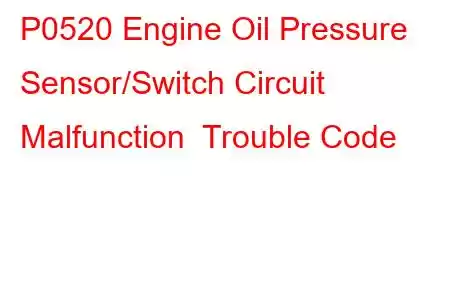P0520 Engine Oil Pressure Sensor/Switch Circuit
OBD-II Trouble Code Technical Description
Engine Oil Pressure Sensor/Switch Circuit
This diagnostic trouble code (DTC) is a generic OBD-II powertrain code. It is considered generic because it applies to all makes and models of vehicles (1996-newer), although specific repair steps may vary depending on the model. In our experience the P0520 engine code appears more often on Chevrolet, Dodge, GMC, Mercedes Benz, Pontiac, and Cadillac, but applies to any make/model.
What does that mean?
The vehicle's main computer called the Powertrain Control Module (PCM) is in control of many sensors, controls, and electronics in the vehicle. One of the sensors called the oil pressure sensor or sender detects the amount of (mechanical) oil pressure in the engine and relays that in the form of a voltage reading/value to the PCM. In some vehicles, that oil pressure value is then relayed to a gauge in the instrument cluster to show the driver the oil pressure, other times that gauge is not there but there will be a warning light if there is a problem.
This specific P0520 diagnostic engine code is triggered when the PCM sees a value from the engine oil pressure sender that is out of it's normal range. For this P0520 trouble code, the cause is most likely electrical related. This code is related to P0521, P0522, P0523, and P0524.
Symptoms
Symptoms of a P0520 DTC may include:
Malfunction Indicator Lamp (MIL) illuminated (a.k.a. Check Engine Light) Oil pressure gauge reading low or high Oil pressure indicator lamp illuminatedCauses
Potential causes of a P0520 code include:
Faulty engine oil pressure sensor Excessive resistance in the oil pressure sensor circuit Short in the circuit to/from the oil pressure sensor and/or PCM and/or ground Faulty PCM (less likely)Diagnostic & Repair Steps
A good starting point is always to check for technical service bulletins (TSB) for your vehicle. Your issue may be a known issue with a known fix put out by the manufacturer and can save you time and money during diagnosis.
Specifically one that we are aware off-hand is Dodge-Chrysler-Ram-Jeep models, it's bulletin # 18-034-14.
As a vehicle owner / DIYer the first obvious thing to do is to check the oil level using the dipstick. You want to make sure there is adequate oil in the engine and the oil filter or drain plug are not leaking or anything like that. It's possible you have low or no oil pressure because you have a leak you are not aware of and the oil is gone. Or, perhaps you just had an oil change and the place forgot to refill the oil, tighten the filter enough, there are different reasons you may have a P0520 or related codes.
Next, visually inspect the wiring and connectors at the oil pressure sending unit. Look for broken or frayed wires, burnt spots, loose or exposed wiring, etc. Make sure electrical connections are tight and not oily or contaminated, etc. Refer to a model specific repair manual for the location of the sender. *Remember codes never indicate what parts to change, rather where to begin diagnosis*.
The next step if nothing looks obvious is to use a digital volt ohm meter (DVOM) to probe the terminals at the oil pressure sensor both on the sensor itself and the associated wiring and harness. Compare to factory specs. Specifically check for shorts to ground, resistance that is not within spec (depends on your model/engine). Repair as necessary.
In all likelihood the fix will be one of two things, a wiring issue that needs repair or a sensor that needs replacement. Replacement of the PCM is more of a last resort and should only be done after proper diagnosis.
Read: 46


